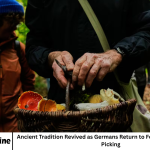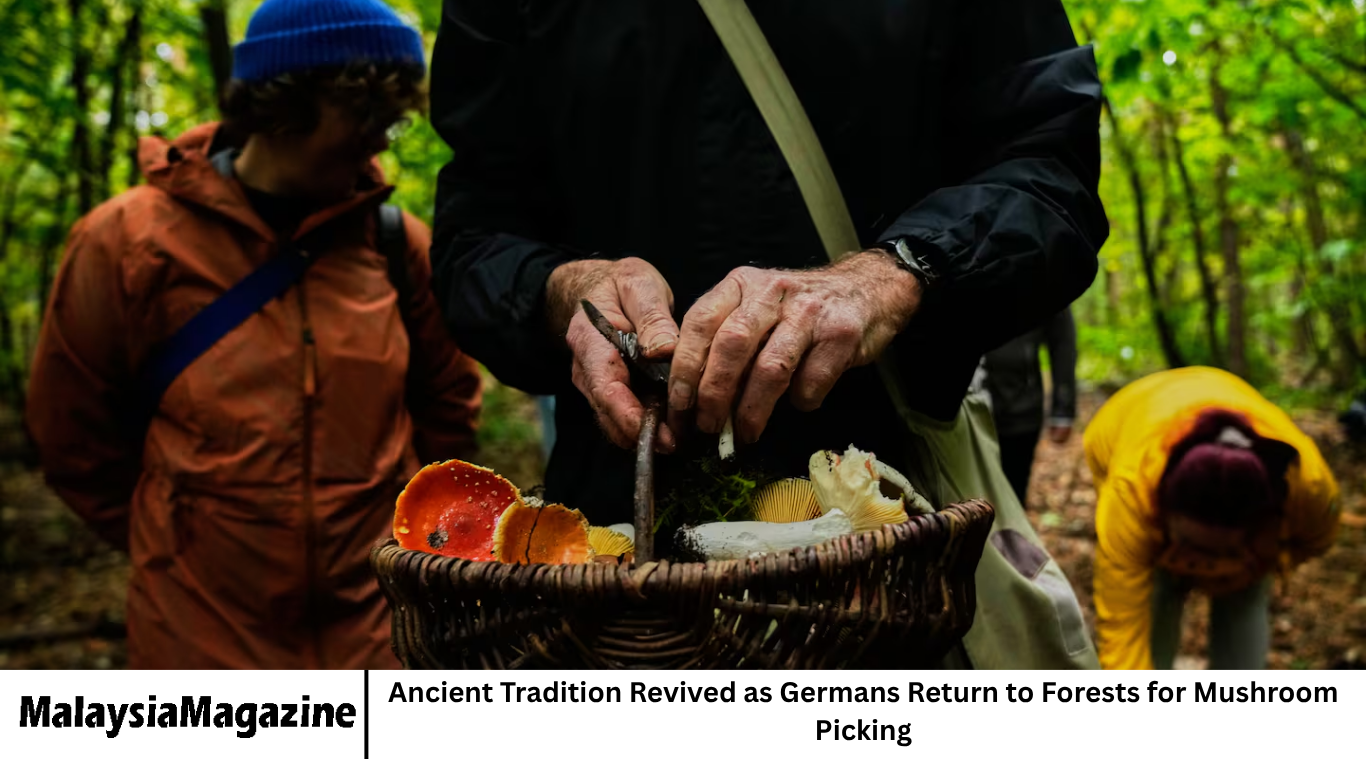Across Germany, a centuries-old autumn tradition is experiencing a beautiful revival. Mushroom picking, once a common pastime for families and rural communities, is drawing thousands of people back into the country’s forests. From experienced foragers to curious newcomers, Germans are rediscovering the joy of searching for edible fungi hidden beneath fallen leaves and moss-covered trees.
This revival is more than a seasonal activity; it reflects a deeper connection to nature, sustainability, and cultural heritage. As modern life grows faster and more digital, many people find comfort in slowing down and engaging with nature through this simple but rewarding practice. Mushroom picking in Germany has become both a recreational and educational experience, promoting environmental awareness and appreciation for the natural world.
The Return of an Old Tradition
Mushroom picking, or Pilzsammeln in German, has long been part of the country’s rural culture. Generations of Germans grew up learning which mushrooms were safe to eat, where to find them, and how to cook them. During and after World War II, when food was scarce, foraging became an essential survival skill.
In recent decades, however, urbanization and busy lifestyles caused the tradition to decline. Many young people lost the knowledge passed down by older generations. But in recent years, this practice has made a strong comeback, driven by renewed interest in healthy living, outdoor recreation, and organic food.
People are once again venturing into forests with baskets and field guides, eager to find porcini, chanterelles, and other prized mushrooms. Social media has also played a role, with nature enthusiasts sharing their discoveries online, inspiring others to join in the hunt.
Why Germans Are Returning to Mushroom Picking
Several factors explain the resurgence of mushroom foraging in Germany. First, the growing emphasis on sustainability and local food has encouraged people to look for natural sources of nourishment. Foraged mushrooms are free, organic, and environmentally friendly, making them an attractive alternative to store-bought produce.
Second, the COVID-19 pandemic rekindled people’s love for outdoor activities. During lockdowns, many Germans discovered that mushroom picking offered both exercise and mental relaxation. Families began to see it as a safe, educational, and bonding activity.
Finally, for many, it’s about nostalgia — a way to reconnect with childhood memories or family roots. Walking through the forest, identifying mushrooms, and cooking them afterward brings a sense of peace and fulfillment that modern life rarely provides.
The Joy of Foraging in German Forests
Germany’s diverse forests are ideal for mushroom picking. From Bavaria’s dense woodlands to the Black Forest’s mossy trails, nature offers an abundance of edible species. The autumn months — typically from September to November — mark the peak season, when moisture and mild temperatures create perfect growing conditions.
Families, friends, and individuals often head out early in the morning, equipped with baskets, knives, and field books. Many bring along magnifying glasses or smartphone apps to identify mushrooms accurately. The thrill lies in the search — spotting the unique shapes and colors peeking through the undergrowth.
The reward is not just the harvest but also the experience. Mushroom picking combines adventure, patience, and mindfulness, allowing participants to slow down, breathe fresh forest air, and appreciate nature’s small wonders.
Learning the Art of Mushroom Identification
While mushroom picking is fun, it also demands knowledge and caution. Germany is home to hundreds of mushroom species, many of which are edible and delicious, but others can be toxic or deadly.
To ensure safety, local nature groups and environmental organizations often host workshops and guided tours. Experienced mycologists — scientists who study fungi — teach participants how to identify safe mushrooms based on their appearance, smell, and habitat.
Commonly collected edible varieties include Steinpilz (porcini), Pfifferling (chanterelle), and Maronenröhrling (bay bolete). Foragers are warned to avoid species that resemble poisonous ones, such as the deadly Knollenblätterpilz (death cap).
German law also restricts how many mushrooms one person can collect, to protect ecosystems and prevent overharvesting. Typically, individuals may pick up to one or two kilograms per day for personal use.
Cultural and Culinary Importance
Mushrooms hold a special place in German cuisine. Traditional dishes such as mushroom soup, creamy sauces, and pan-fried chanterelles with potatoes are popular during the autumn months. Many families enjoy cooking their freshly gathered mushrooms immediately after returning from the forest, often accompanied by homemade bread and herbs.
The culinary joy of mushroom season also extends to local markets and restaurants. Chefs celebrate the harvest by featuring wild mushroom dishes on their menus, highlighting regional flavors and seasonal freshness.
Beyond food, mushroom picking reflects deeper cultural values of simplicity, connection to the land, and appreciation for natural cycles. It’s an activity that bridges generations, combining heritage with modern mindfulness.
Environmental Awareness and Sustainability
The resurgence of mushroom picking is also part of a broader environmental movement in Germany. Foraging encourages people to spend more time outdoors, observe ecosystems, and respect biodiversity. It fosters understanding of how fungi play an essential role in forest health by breaking down organic matter and supporting plant growth.
Many environmental groups emphasize responsible foraging — taking only what you need, leaving young mushrooms to mature, and avoiding damage to the forest floor. Such practices ensure that future generations can continue to enjoy this age-old activity without harming the environment.
Mushroom picking also raises awareness about climate change. Fungi are sensitive to weather patterns, and scientists use their growth cycles to study ecological changes. By participating in citizen foraging, people indirectly contribute to environmental observation and data collection.
Economic and Tourism Impact
The growing popularity of mushroom foraging has also given rise to a small but thriving tourism sector. Guided foraging tours, nature retreats, and weekend workshops attract both locals and international visitors.
Regions like Bavaria, Thuringia, and Saxony have become popular destinations for mushroom enthusiasts. Some hotels even offer “foraging packages,” combining forest walks with cooking classes that teach guests how to prepare their finds.
Local economies benefit as well, with seasonal markets selling freshly picked mushrooms, handmade baskets, and traditional tools. This blend of ecology, culture, and tourism demonstrates how an ancient tradition can create modern opportunities.
The Role of Education and Science
Schools and environmental centers across Germany are integrating mushroom foraging into their nature education programs. Children learn about forest ecosystems, species identification, and the importance of fungi in soil health.
Scientific interest in fungi is also growing. Universities and research institutes are studying mushrooms for their potential medical and environmental benefits. Some species are known to produce natural antibiotics, while others help absorb pollutants or promote soil regeneration.
By blending traditional knowledge with modern science, Germany is showing how old practices can inspire innovative thinking and sustainable solutions.
Mushroom Picking as a Mindful Practice
For many, mushroom picking is more than just a hobby — it’s a form of mindfulness. The quiet of the forest, the focus required to spot hidden mushrooms, and the sense of accomplishment all contribute to mental well-being.
In a fast-paced digital world, this activity offers a rare chance to disconnect from technology and reconnect with the senses. The rhythmic sound of footsteps on leaves, the earthy smell of soil, and the soft light filtering through trees create a calming, almost meditative experience.
Psychologists say such nature-based activities reduce stress and improve mood. They also strengthen community bonds when done with family or friends.
Challenges and Modern Risks
Despite its growing popularity, mushroom picking comes with challenges. Misidentification remains a significant risk. Every year, poison control centers report cases of accidental mushroom poisoning caused by confusion between edible and toxic varieties.
To minimize danger, authorities urge beginners to avoid eating wild mushrooms unless verified by an expert. Many towns have “mushroom check” stations where trained specialists identify specimens free of charge.
Another concern is the pressure on natural habitats. In some popular regions, overharvesting and trampling can disrupt delicate ecosystems. Responsible foraging practices are crucial to maintaining the balance between tradition and conservation.
Germany’s Deep Connection to Nature
Mushroom picking reflects Germany’s long-standing relationship with its forests. The country’s folklore, fairy tales, and literature often depict enchanted woods filled with mystery and magic. For many, wandering into the forest in search of mushrooms is like stepping into a living story — one that connects them to their ancestors and the natural world.
This bond with nature continues to shape German identity. Whether through hiking, gardening, or foraging, people maintain a respect for the land that sustains them. Mushroom picking embodies that harmony — a simple, sustainable act that celebrates life’s natural rhythms.
Future of the Tradition
As younger generations rediscover mushroom foraging, the future of this tradition looks bright. Digital tools like identification apps and online guides make it easier for beginners to learn safely. Social media platforms foster communities where foragers share advice and experiences.
At the same time, educators and conservationists stress the importance of preserving traditional knowledge — the wisdom once passed down by grandparents around the kitchen table. Combining modern technology with ancestral skills ensures that mushroom picking remains both safe and meaningful.
The trend also fits into global movements promoting sustainable lifestyles and eco-tourism. Germany’s success in reviving this practice could inspire other countries to reintroduce traditional ways of living harmoniously with nature.
Frequently Asked Questions
Why is mushroom picking popular again in Germany?
Many Germans are returning to mushroom picking as a way to connect with nature, enjoy healthy outdoor activities, and promote sustainable living.
When is the best time for mushroom picking in Germany?
The peak season runs from September to November, when weather conditions are ideal for mushroom growth.
What are some common edible mushrooms found in Germany?
Popular varieties include porcini (Steinpilz), chanterelles (Pfifferling), and bay boletes (Maronenröhrling).
Are there any risks involved in mushroom picking?
Yes, some mushrooms are poisonous and look similar to edible ones. Beginners should always consult experts before eating wild mushrooms.
How does Germany protect its forests from overharvesting?
There are legal limits on how many mushrooms individuals can collect, and conservation groups promote responsible foraging practices.
Can tourists participate in mushroom picking in Germany?
Yes, many regions offer guided tours and workshops for locals and tourists interested in safe foraging experiences.
What cultural significance does mushroom picking hold in Germany?
It’s a long-standing tradition that symbolizes connection to nature, family bonding, and appreciation for simple, natural living.
How is modern technology influencing mushroom picking?
Smartphone apps and online communities help new foragers identify species safely and share their experiences with others.
Conclusion
The return of mushroom picking in Germany is a heartwarming example of how old traditions can find new life in modern times. It brings together health, culture, and sustainability, offering people a way to reconnect with nature while preserving their heritage.
In the quiet forests, beneath canopies of autumn leaves, Germans are once again rediscovering the simple pleasure of searching for mushrooms — an act that nourishes the body, mind, and spirit. As this movement continues to grow, it reminds us all of the enduring power of nature and the importance of keeping our cultural roots alive.














